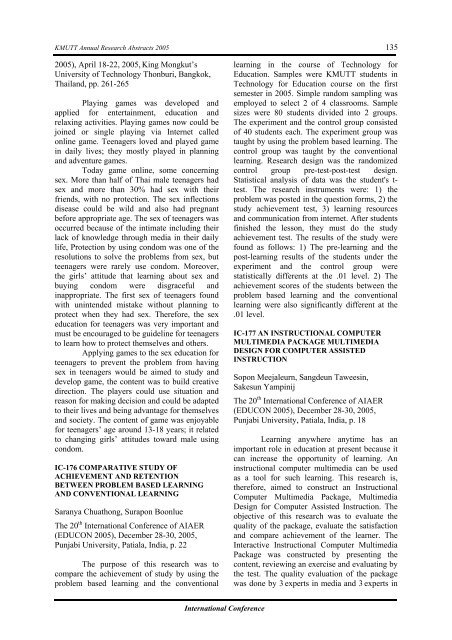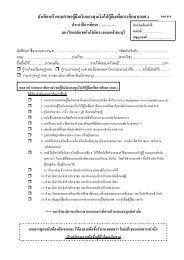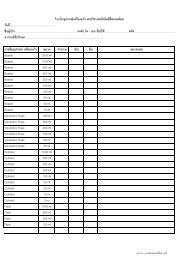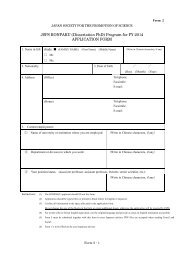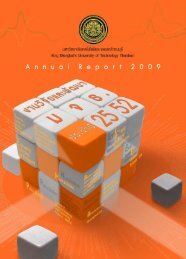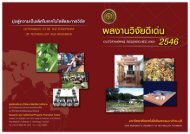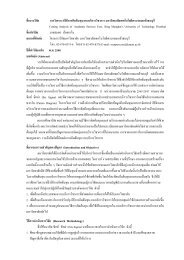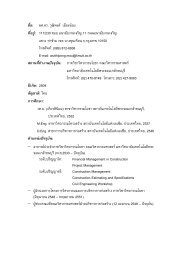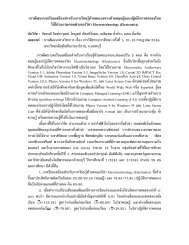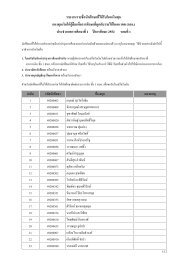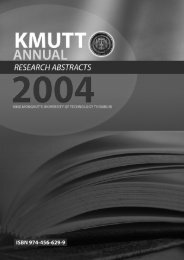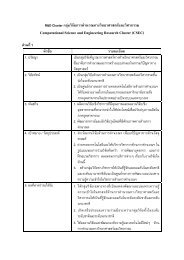Create successful ePaper yourself
Turn your PDF publications into a flip-book with our unique Google optimized e-Paper software.
KMUTT Annual Research Abstracts 2005<br />
2005), April 18-22, 2005, King Mongkut’s<br />
University of Technology Thonburi, Bangkok,<br />
Thailand, pp. 261-265<br />
Playing games was developed and<br />
applied for entertainment, education and<br />
relaxing activities. Playing games now could be<br />
joined or single playing via Internet called<br />
online game. Teenagers loved and played game<br />
in daily lives; they mostly played in planning<br />
and adventure games.<br />
Today game online, some concerning<br />
sex. More than half of Thai male teenagers had<br />
sex and more than 30% had sex with their<br />
friends, with no protection. The sex inflections<br />
disease could be wild and also had pregnant<br />
before appropriate age. The sex of teenagers was<br />
occurred because of the intimate including their<br />
lack of knowledge through media in their daily<br />
life, Protection by using condom was one of the<br />
resolutions to solve the problems from sex, but<br />
teenagers were rarely use condom. Moreover,<br />
the girls’ attitude that learning about sex and<br />
buying condom were disgraceful and<br />
inappropriate. The first sex of teenagers found<br />
with unintended mistake without planning to<br />
protect when they had sex. Therefore, the sex<br />
education for teenagers was very important and<br />
must be encouraged to be guideline for teenagers<br />
to learn how to protect themselves and others.<br />
Applying games to the sex education for<br />
teenagers to prevent the problem from having<br />
sex in teenagers would be aimed to study and<br />
develop game, the content was to build creative<br />
direction. The players could use situation and<br />
reason for making decision and could be adapted<br />
to their lives and being advantage for themselves<br />
and society. The content of game was enjoyable<br />
for teenagers’ age around 13-18 years; it related<br />
to changing girls’ attitudes toward male using<br />
condom.<br />
IC-176 COMPARATIVE STUDY OF<br />
ACHIEVEMENT AND RETENTION<br />
BETWEEN PROBLEM BASED LEARNING<br />
AND CONVENTIONAL LEARNING<br />
Saranya Chuathong, Surapon Boonlue<br />
The 20 th International Conference of AIAER<br />
(EDUCON 2005), December 28-30, 2005,<br />
Punjabi University, Patiala, India, p. 22<br />
The purpose of this research was to<br />
compare the achievement of study by using the<br />
problem based learning and the conventional<br />
135<br />
learning in the course of Technology for<br />
Education. Samples were KMUTT students in<br />
Technology for Education course on the first<br />
semester in 2005. Simple random sampling was<br />
employed to select 2 of 4 classrooms. Sample<br />
sizes were 80 students divided into 2 groups.<br />
The experiment and the control group consisted<br />
of 40 students each. The experiment group was<br />
taught by using the problem based learning. The<br />
control group was taught by the conventional<br />
learning. Research design was the randomized<br />
control group pre-test-post-test design.<br />
Statistical analysis of data was the student's t-<br />
test. The research instruments were: 1) the<br />
problem was posted in the question forms, 2) the<br />
study achievement test, 3) learning resources<br />
and communication from internet. After students<br />
finished the lesson, they must do the study<br />
achievement test. The results of the study were<br />
found as follows: 1) The pre-learning and the<br />
post-learning results of the students under the<br />
experiment and the control group were<br />
statistically differents at the .01 level. 2) The<br />
achievement scores of the students between the<br />
problem based learning and the conventional<br />
learning were also significantly different at the<br />
.01 level.<br />
IC-177 AN INSTRUCTIONAL COMPUTER<br />
MULTIMEDIA PACKAGE MULTIMEDIA<br />
DESIGN FOR COMPUTER ASSISTED<br />
INSTRUCTION<br />
Sopon Meejaleurn, Sangdeun Taweesin,<br />
Sakesun Yampinij<br />
The 20 th International Conference of AIAER<br />
(EDUCON 2005), December 28-30, 2005,<br />
Punjabi University, Patiala, India, p. 18<br />
Learning anywhere anytime has an<br />
important role in education at present because it<br />
can increase the opportunity of learning. An<br />
instructional computer multimedia can be used<br />
as a tool for such learning. This research is,<br />
therefore, aimed to construct an Instructional<br />
Computer Multimedia Package, Multimedia<br />
Design for Computer Assisted Instruction. The<br />
objective of this research was to evaluate the<br />
quality of the package, evaluate the satisfaction<br />
and compare achievement of the learner. The<br />
Interactive Instructional Computer Multimedia<br />
Package was constructed by presenting the<br />
content, reviewing an exercise and evaluating by<br />
the test. The quality evaluation of the package<br />
was done by 3 experts in media and 3 experts in<br />
International Conference


